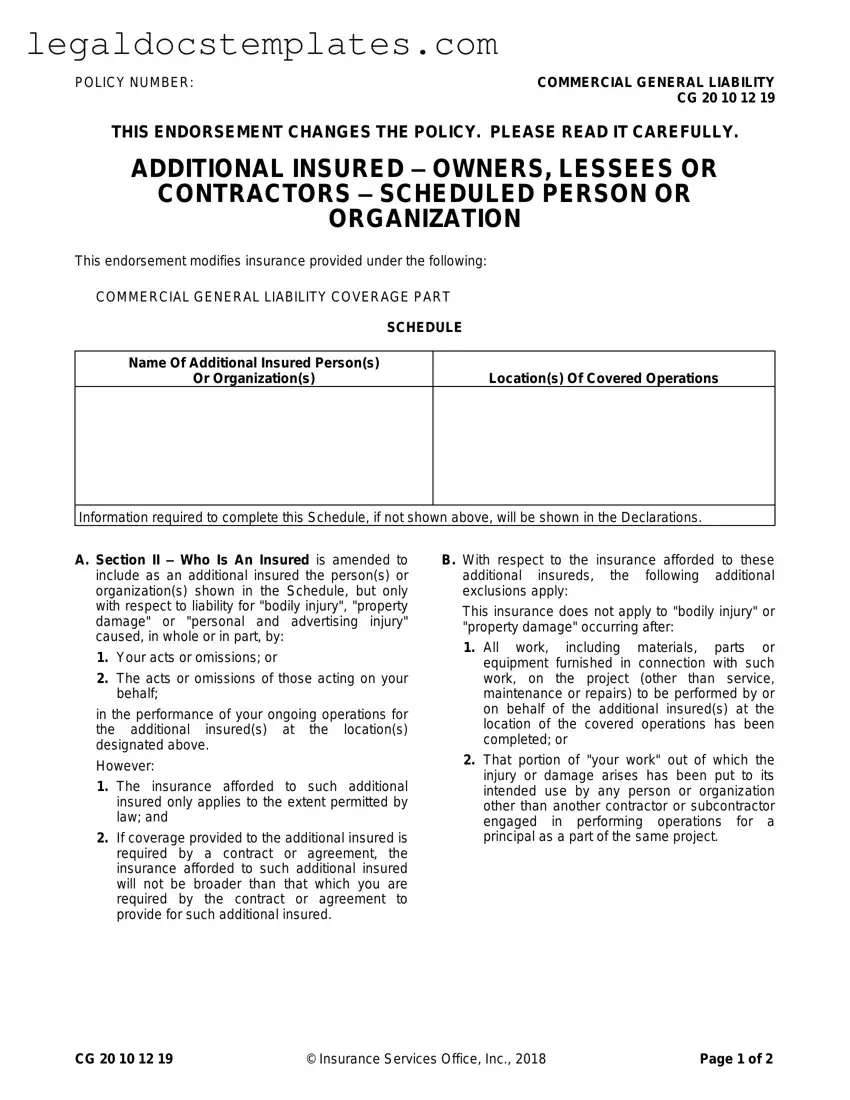The CG 20 37 (Additional Insured – Owners, Lessees or Contractors – Automatic Status When Required in Construction Agreement With You) is a document that shares similarities with the CG 20 10 by providing additional insured status to certain parties in a construction project. Both forms are designed to extend coverage to owners, lessees, or contractors when a contract necessitates such coverage. However, the CG 20 37 automatically grants this status when a written contract requires it, without the need to individually schedule each additional insured. This broadens the insurance coverage umbrella for parties involved in construction projects, mirroring the intention behind the CG 20 10 to safeguard against risks from operations performed by or on behalf of the named insured.
The CG 20 33 (Additional Insured – Owners, Lessees or Contractors – Completed Operations) also parallels the CG 20 10, specifically in the context of offering additional insured status. While the CG 20 10 focuses on ongoing operations, the CG 20 33 extends this coverage to include completed operations. This distinction is crucial for parties requiring protection from liability or damages that occur after the named insured's work on the project is finished. Both forms address the need for extending liability coverage beyond the immediate terms of engagement, ensuring comprehensive protection against potential legal or financial liabilities.
Another related document, the CG 00 01 (Commercial General Liability Coverage Form), underpins the structure of the CG 20 10. It outlines the fundamental liability coverage that the CG 20 10 amends to include additional insureds. The CG 00 01 sets the stage by detailing the core coverage areas, exclusions, and limits of insurance, which are then modified by the CG 20 10 to accommodate the needs of additional insureds. Through this interaction, the endorsement form and the base policy work in tandem to create a customized insurance solution for commercial entities.
The CA 20 48 (Pollution Liability Broadened Coverage for Covered Autos) endorsement shares a thematic resemblance with the CG 20 10, insofar as both modify an existing policy to meet specific coverage needs. While the CG 20 10 addresses general liability issues by adding additional insureds, the CA 20 48 focuses on broadening auto liability coverage to include pollution liability events. These endorsements represent the insurance industry's flexibility in adapting base policies to cover a wide range of risk exposures through targeted adjustments.
Similarly, the CG 24 26 (Amendment of Insured Contract Definition) endorsement impacts the scope of covered activities and responsibilities under a commercial general liability policy, echoing the purpose of the CG 20 10 to modify existing coverage. By altering the definition of an "insured contract," this form can significantly influence the extent of liability protection provided, just as the CG 20 10 aims to explicitly define the coverage parameters for additional insureds. Both forms are essential tools in managing the risks associated with contractual relationships and operations.
The ISO Form CP 00 10 (Building and Personal Property Coverage Form) is involved in property insurance, yet it relates to the CG 20 10 through its role in shaping comprehensive risk management strategies. While it primarily concerns property damage and loss, the methodology of outlining coverage, exclusions, and endorsements mirrors the CG 20 10’s approach to modifying general liability coverage. Together, these forms exemplify how various types of insurance are structured to protect commercial interests comprehensively.

